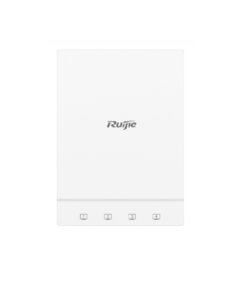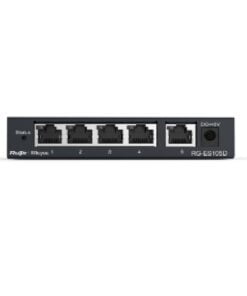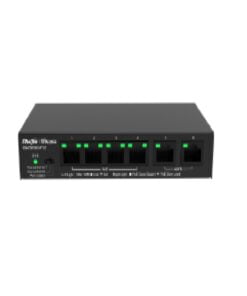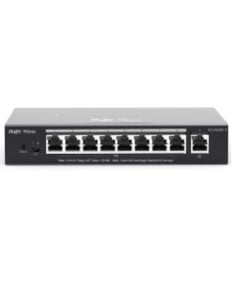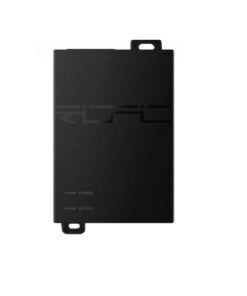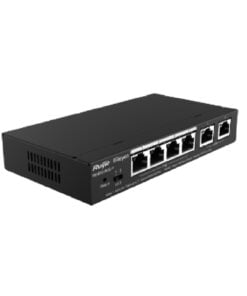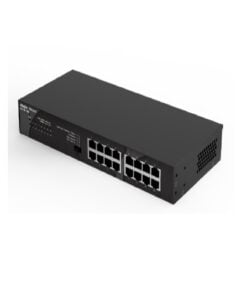No products in the cart.


RUIJIE WIRELESS CONTROLLER (RG-WS6008)
₱98,940.00
Easy Web Management
The Ruijie WS6008 wireless controller supports a web management interface, which provides simplified wireless initial provisioning, configuration and high visibility for the whole network operation.
Artificial Intelligent Cloud Service
Ruijie WIS is an AI-based intelligent service designed for Wi-Fi optimization on the cloud. Seamlessly integrated with Ruijie hardware AC on-premises helps to streamline Wi-Fi deployment planning, delivery testing as well as operation diagnosis.
Application Scenario
The Ruijie WS6008 wireless controller provides the unified management platform to manage wireless AP in the campus network. It is also integrated with the Ruijie WIS platform on the cloud to further enhance Wi-Fi optimization services, managed AP up to 448 units, ideal for small to medium business environment.
SKU: RUIJIE WIRELESS CONTROLLER (RG-WS6008)
Category: Ruijie
Tag: RUIJIE WIRELESS CONTROLLER (RG-WS6008)
| Dimensions and Weight | RG-WS6008 |
| Dimensions (W x D x H) | 440 mm x 200 mm x 43.6 mm (17.4 in. x 7.9 in. x 1.8 in.) |
| Rack height | 1 RU |
| Weight | 2.9 kg (6.4 lbs) |
Ports
| Ports | RG-WS6008 |
| Fixed service port | 6 x 10/100/1000Base-T Ethernet ports with auto-negotiation. ● Auto MDI/MDIX crossover ● Port 1 can be used as an out-of-band management port. 2 x combo ports, when the combo port is used as an electrical port, it supports ● 10/100/1000Base-T auto-negotiation ● Auto MDI/MDIX crossover |
| Fixed management port | 1 x RJ45 console port 2 x USB ports |
| Status LED | 1 x system status LED 1 x power status LED 10 x service port LEDs |
| Button | 1 x Reset button ● Press the button for shorter than 3 seconds. Then the device restarts. ● Press the button for longer than 3 seconds. Then the device restores to factory settings. 1 x Power switch button |
Power Supply and Consumption
| Power Supply and Consumption | RG-WS6008 |
| Max. power consumption | 40 W |
| Power module | 1 x 40 W built-in power module |
| Input voltage | 100 V AC to 240 V AC, 50 Hz to 60 Hz |
| Input current | 1.5 A (max. RMS current) |
| Output voltage | 12 V/3.33 A |
Environment and Reliability
| Environment and Reliability | RG-WS6008 |
| Temperature | Operating temperature: 0°C to 45°C (32°F to 113°F) Storage temperature: –40°C to +70°C (–40°F to +158°F) Note: At an altitude between 3,000 m (9,843 ft.) and 5,000 m (16,404 ft.), every time the altitude increases by 220 m (722 ft.), the maximum temperature decreases by 1°C (1.8°F). |
| Operating altitude | 0 m to 3000 m (0 ft to 9843 ft.) |
| Humidity | Operating humidity: 10% to 90% RH (non-condensing) Storage humidity: 5% to 95% RH (non-condensing) |
| Fan | Fan speed adjustment Fan fault alarm |
| Acoustic noise | < 78 dB |
| Mean Time Between Failure (MTBF) | 200,000 hours (22 years) at the operating temperature of 25°C (77°F) |
Certifications and Regulatory Compliance
| Certifications and Regulatory Compliance | RG-WS6008 |
| Safety regulations | GB 4943.1 CE Marked, EN/IEC 62368-1 (replacing EN/IEC 60950-1) Low Voltage Directive 2014/35/EU |
| EMC regulations | EN 300 386, EN301 489, EN 55032 Class A, EN 55035, EN 61000-3-2, EN 61000-3-3, EN 61000-4-2, EN 61000-4-3, EN 61000-4-4,EN 61000-4-5, EN 61000-4-6, EN 61000-4-8, EN 61000-4-11 |
*For more country-specific regulatory information and approvals, contact your local sales agency.
Software Specifications
Performance and Capacity
| Performance and Capacity | RG-WS6008 |
| WLAN | |
| Default number of manageable APs | 32 Note: The default number of APs that can be managed by the RG-WS6008 is subject to the AP model. See the Ordering Information for details. |
| Max. number of configurable APs | 2,048 |
| Max. number of manageable APs | 448 Note: The maximum number of APs that can be managed by the RG-WS6008 is subject to the AP model. See the Ordering Information for details. |
| Maximum number of manageable STAs | 7,168 Note: The maximum number of STAs that can be managed by the RG-WS6008 is subject to the network environment. Contact technical support team for details. |
| WLAN service | Max. number of WLAN IDs: 2,048 Max. number of associated STAs per WLAN: 7,168 |
| Intra-AC roaming handoff time | < 50 ms |
| Max. number of virtualized ACs | 4 |
| Number of concurrent CAPWAP data channels | 2,688 |
| Routing and Switching | |
| Number of MAC address entries | 32,768 |
| Number of VLANs | 4,096 |
| Number of ARP entries | 32,768 |
| DHCP address pools | Number of IPv4 address pools: 2,000 Number of IPv4 addresses: 24,576 Number of IPv6 address pools: 256 Number of IPv6 addresses: 2,048 |
| Number of routing entries | IPv4 routing entries: 8,192 IPv6 routing entries: 10,000 |
| Number of multicast entries | Static routing entries: 2,048 Multicast group routing entries: 4,096 |
| Security and Authentication | |
| Max. number of STAs supported by the built-in Portal server | 1,500 |
| Number of ACL entries | 65,536 |
Applicable Software Version
| Applicable Software Version | RG-WS6008 |
| Applicable software version | RGOS11.9(6)W1B1 or later |
WLAN
| WLAN | RG-WS6008 |
| IEEE 802.11 protocols | 802.11, 802.11b, 802.11a, 802.11g, 802.11d, 802.11h, 802.11w, 802.11k, 802.11v, 802.11r, 802.11i, 802.11e, 802.11n, 802.11ac, and 802.11ax |
| CAPWAP | Layer 2 and Layer 3 topology between an AP and an AC An AP can automatically discover the accessible AC. An AP can be automatically upgraded through the AC. An AP can automatically download the configuration file from the AC. CAPWAP through NAT |
| Roaming | Intra-AC Layer 2 or Layer 3 roaming Inter-AC Layer 2 or Layer 3 roaming |
| Forwarding mode | Centralized forwarding Local forwarding Service-based flexible forwarding |
| Wireless QoS | AP/WLAN/STA-based rate limiting (WLAN/STA-based rate limit range: 8-261,120 in the unit of 8 Kbps. For example, if you set the value to 8, the rate limit is 8 x 8 Kbps = 64 Kbps.) Static and intelligent rate limiting based on STA quantity Fair scheduling |
| User isolation | AC-based user isolation AP-based user isolation WLAN-based user isolation |
| Reliability | AC virtualization AC failover Multi-AC hot standby (1+1 A/A and A/S hot standby, and N+1 hot standby) Multi-AC cluster (N-to-N) Remote intelligent perception technology (RIPT) Non-stop service during upgrade |
| STA management | Access control based on the number of STAs associated with the AP Access control based on the number of STAs associated with the SSID Balanced access control based on the number of STAs associated with the AP Balanced access control based on the AP traffic Band steering Configuration of the RSSI threshold in dB (Range: 0-100) Configuration of the STA idle timeout period in seconds (range: 60-86,400) |
| WLAN optimization | Adjustment of the transmit power for beacon packets or probe responses |
| RF management | Country or region code setting Manual setting of the transmit power Automatic setting of the transmit power Manual setting of the operating channel Automatic setting of the operating channel Automatic adjustment of the data rate Coverage hole compensation AP load balancing based on traffic and STA quantity Band selection Radio Frequency Interference (RFI) detection and mitigation |
Security
| Security | RG-WS6008 |
| IPv4 security authentication | Web authentication 802.1X authentication MAB authentication SMS authentication QR code-based authentication |
| IPv6 security authentication | Web authentication |
| IEEE 802.11 security and encryption | Multi-SSID mode SSID hiding IEEE 802.11i-compliant PSK authentication WPA and WPA2 WPA3: WPA3-Personal (SAE), WPA3-Enterprise (CCMP, 128-bit), and WPA3-Enterprise (GCMP, 192-bit) WEP (WEP/WEP128) TKIP CCMP Anti-ARP spoofing |
| CPP | Supported |
| NFPP | Supported |
| WIDS | Supported |
| AP virtualization | Supported |
Protocols
| Protocols | RG-WS6008 |
| IPv4 protocols | Ping and traceroute DHCP server, DHCP client, DHCP relay, and DHCP snooping DNS client NTP Telnet TFTP server and TFTP client FTP server and FTP client |
| IPv6 protocols | DNSv6 client DHCPv6 relay and DHCPv6 server TFTPv6 client FTPv6 server and FTPv6 client IPv6 CAPWAP ICMPv6 IPv6 ping Manual tunnels and automatic tunnels Manually configured IP addresses and automatically created local addresses IPv6 traceroute |
| IPv4 routing | Static routing, RIP, and OSPF |
| IPv6 routing | Static routing |
Management
| Management | RG-WS6008 |
| Network management | SNMP v1/v2c/v3 RMON Syslog |
| Network management platform | Eweb Ruijie Cloud RIIL Wi-Fi heat map |
| User access management | Console port login,Telnet login,SSH login,and FTP upload |
Related products
₱8,250.00
₱1,480.00
₱4,700.00



